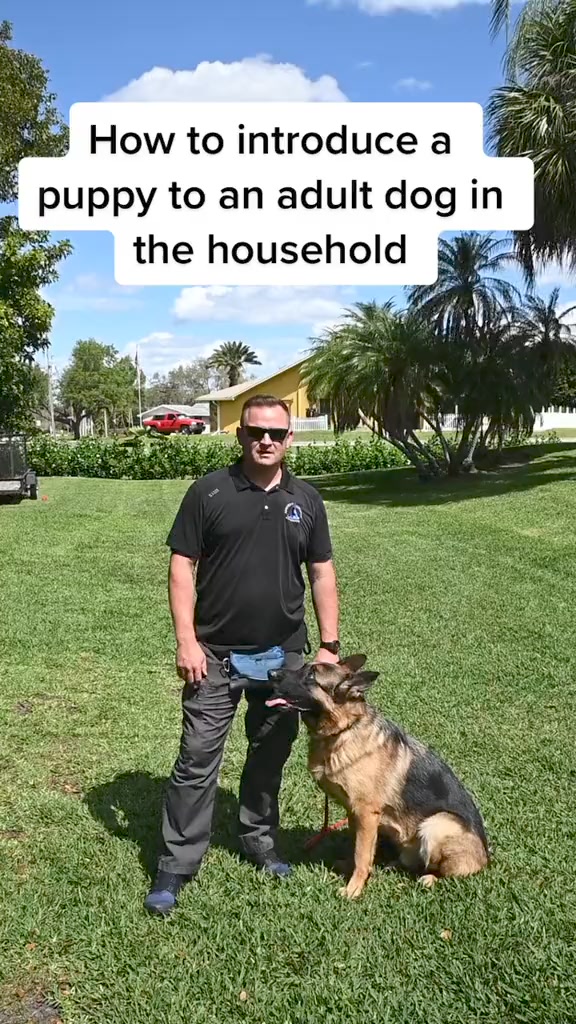Tagged: INTRODUCTION Puppy to Adult Dog
-
How Do You Introduce a Puppy to Your Adult Dog
Posted by Rocky on August 16, 2024 at 10:04 pmAte you planning on buying a puppy and introducing to your adult dog in your household?
https://www.facebook.com/share/r/VSvuREwFkMsm3TJf/?mibextid=D5vuiz
facebook.com
Introducing your puppy to your adult dog. #puppytraining #puppytrainer #DogTraining #dogtrainingtips #professionaldogtrainer #dogtraineroftiktok #dogt. Asong Brothers · Audio asli
Rocky replied 9 months, 2 weeks ago 1 Member · 1 Reply -
1 Reply
-
Introducing another puppy to your adult dog can be a refreshing but sensitive experience. To make sure that everything goes well and your pets get along with each other, follow this guide: Preparations are to be made before bringing the puppy home.
Safe Space: Create a separate area, such as a crate or playpen, where the new pup can feel safe and adjust slowly to its new surroundings.
Supplies: Ensure you have all the necessary supplies, including food and water bowls, toys, and bedding. This establishes a routine and reduces stress for both animals.
Keep Adult Dog’s Routine Constant: Changes in routine may cause anxiety; therefore, it is important to feed them at their normal time, take them for walks, and play with them accordingly.
- First Introduction
Neutral Territory: Introduce both dogs to a neutral place, such as a park or a friend’s backyard, so they don’t exhibit territorial behavior.
Controlled Environment: Have both pets on a leash during their first meeting. Allow them to sniff each other calmly while watching for positive signs such as wagging tails and relaxed body postures.
Short & Sweet: Keep initial interactions short-lived but positive, then separate them after a few minutes to avoid overexciting one another.
Introducing the Puppy at Home
Interactions should be supervised: Within the first days of arrival, closely monitor how the puppy interacts with an adult dog. When they become comfortable being around each other more often, you may lengthen the time spent together.
Separate Spaces: Provide eating areas and sleeping places for puppies separately from those meant for older dogs so that no canine guards the resources, which could lead to fights between them. If possible, give adult dogs some rest, too.
Positive Reinforcement: Whenever either dog behaves calmly towards the opposite sex member, reward it using treats or praise. This will help create good memories about one another, strengthening bonds between these two breeds—positive reinforcement.
Managing the Transition
Respect Boundaries: Allow your older dog to gently correct your younger one since it’s natural for adult dogs to correct young ones. Only interrupt if things go beyond acceptable levels of interaction between them.
Gradual Integration: Slowly increase the duration of time puppies spend together so they can learn appropriate behaviors from their seniors. However, ensure supervision when playing together so safety measures are followed throughout these sessions.
Equal Attention: Avoid making adult dogs jealous by spending quality time with each separately. More attention should also be given to the adult canine, which helps prevent any feelings of neglect that could arise due to the arrival of another pet into the family setup.
Handling Challenges
Signs of Stress: If signs like growling, snapping, or excessive barking are observed in any party, then separate them temporarily before trying again when both have calmed down completely.
Training and Obedience: Teach basic commands such as sit and stay among others to all involved parties. It lets you control their actions while interacting, keeping everyone safe during such moments. It also serves as a medium through which these animals bond even further with one another – training sessions.
Consult a Professional: If integration proves difficult or aggression starts showing up, consider hiring a professional dog trainer or behaviorist who can offer the guidance necessary for a successful outcome.
Building a Lasting Bond
Consistent Routine: Create a regular schedule, including feeding time. Walking periods and playtimes are for both dogs because consistency breeds familiarity, thereby reducing stress levels during this period.
Joint Activities: Involve them in joint activities like walking together, playing games, etc.; shared experiences help build stronger bonds between different breeds, thus promoting harmonious living within the same household setup – joint activities.
Patience is Key: It takes time for your two pets’ relationship to grow strong. Thus, let them adjust at their own speed without pushing too hard; otherwise, they may never get along well.
Closing
Meticulous preparation, watching closely, and patience are necessary when bringing a new puppy into your home with an adult dog. You can promote a peaceful coexistence between them by moving gradually, rewarding good behavior, and considering the limits of each animal. If you encounter difficulties, consult an expert for a smooth changeover phase.

